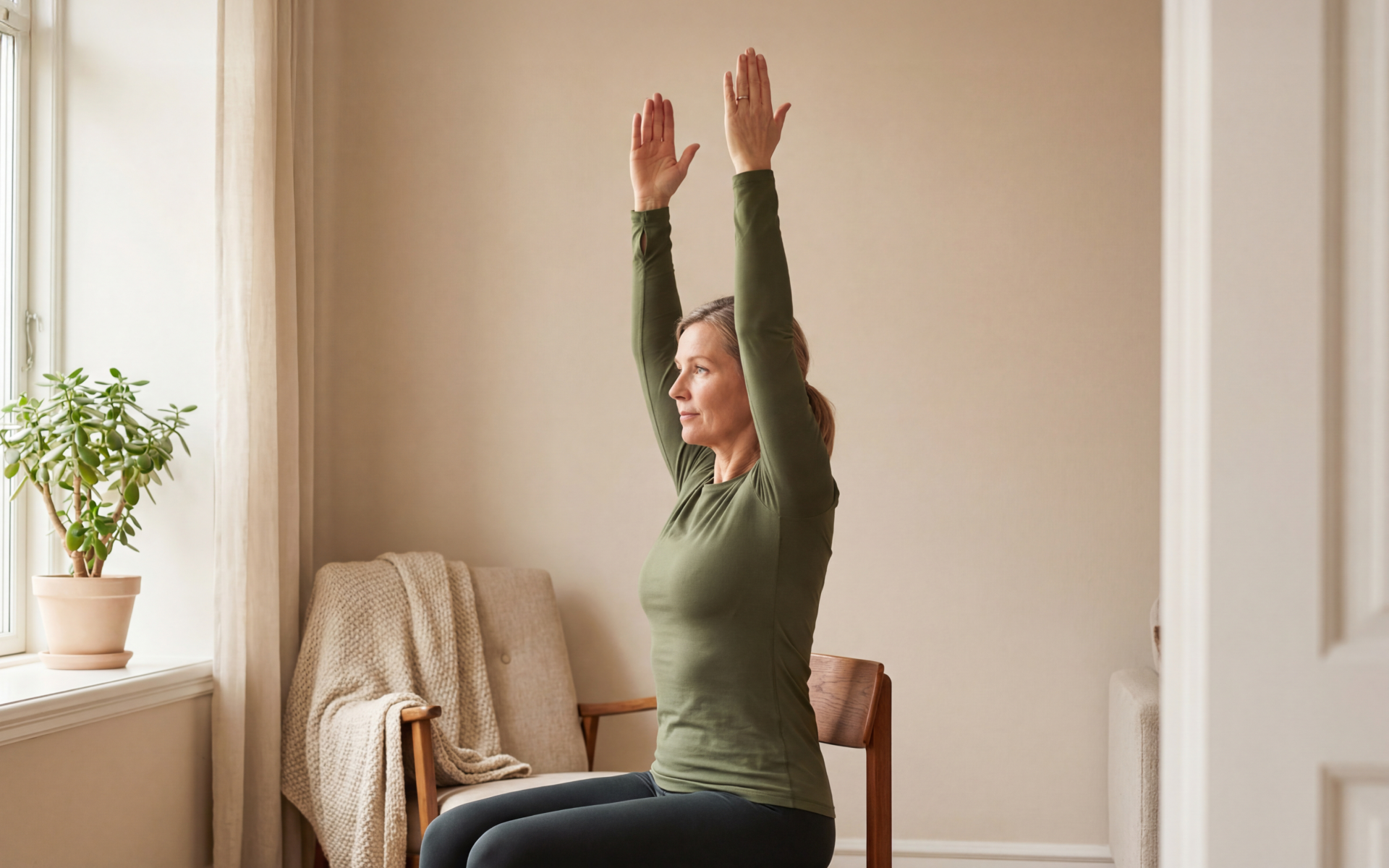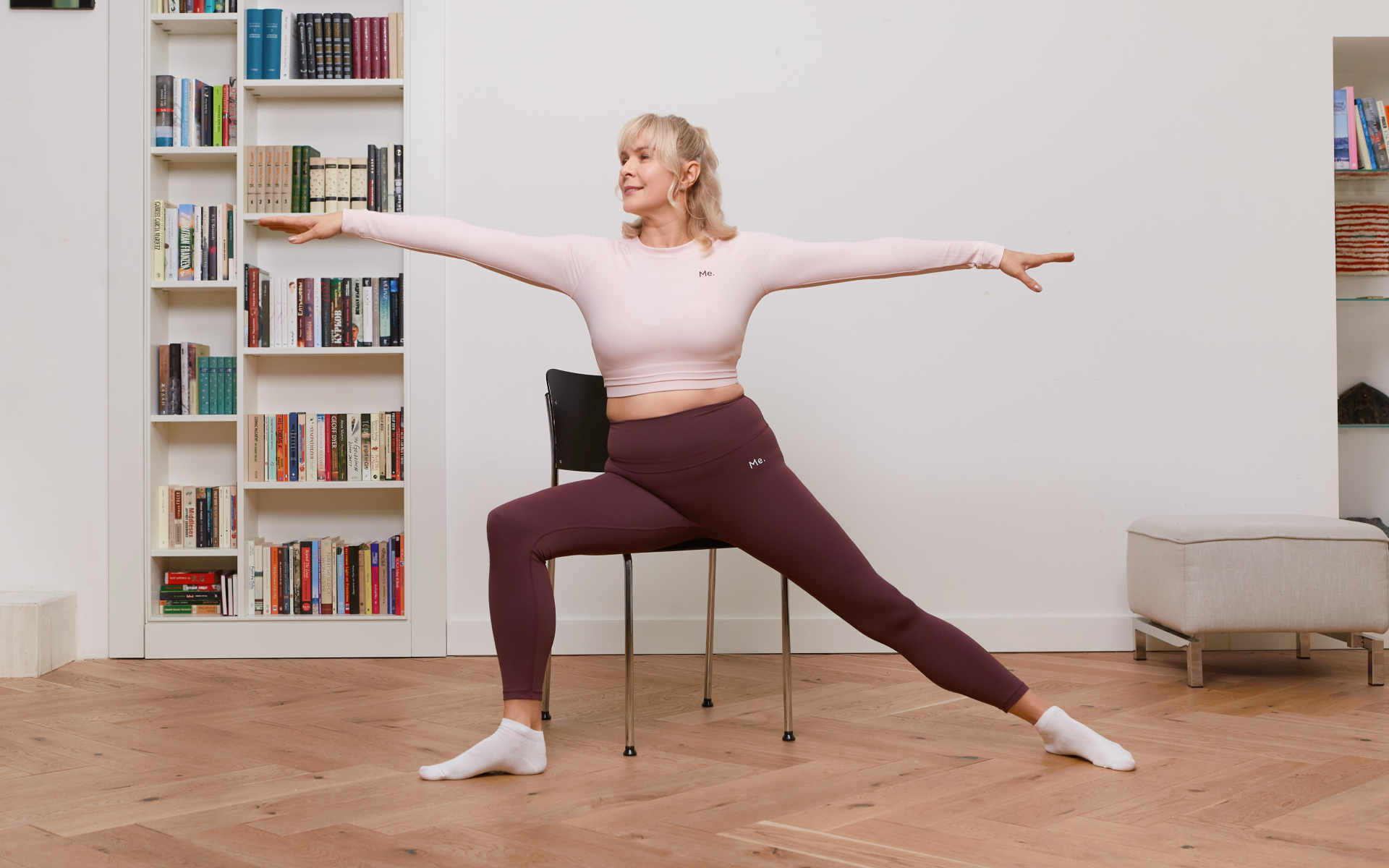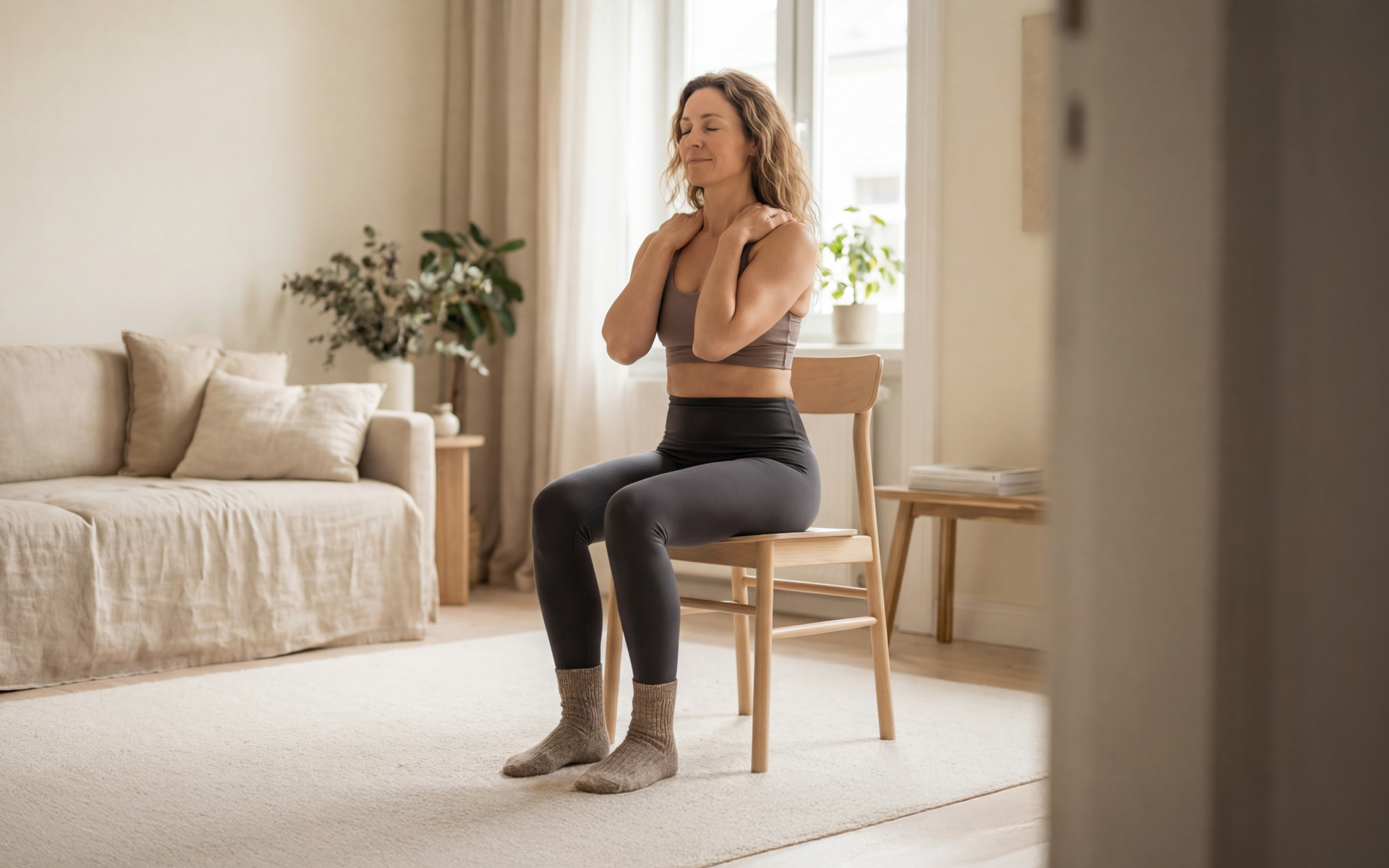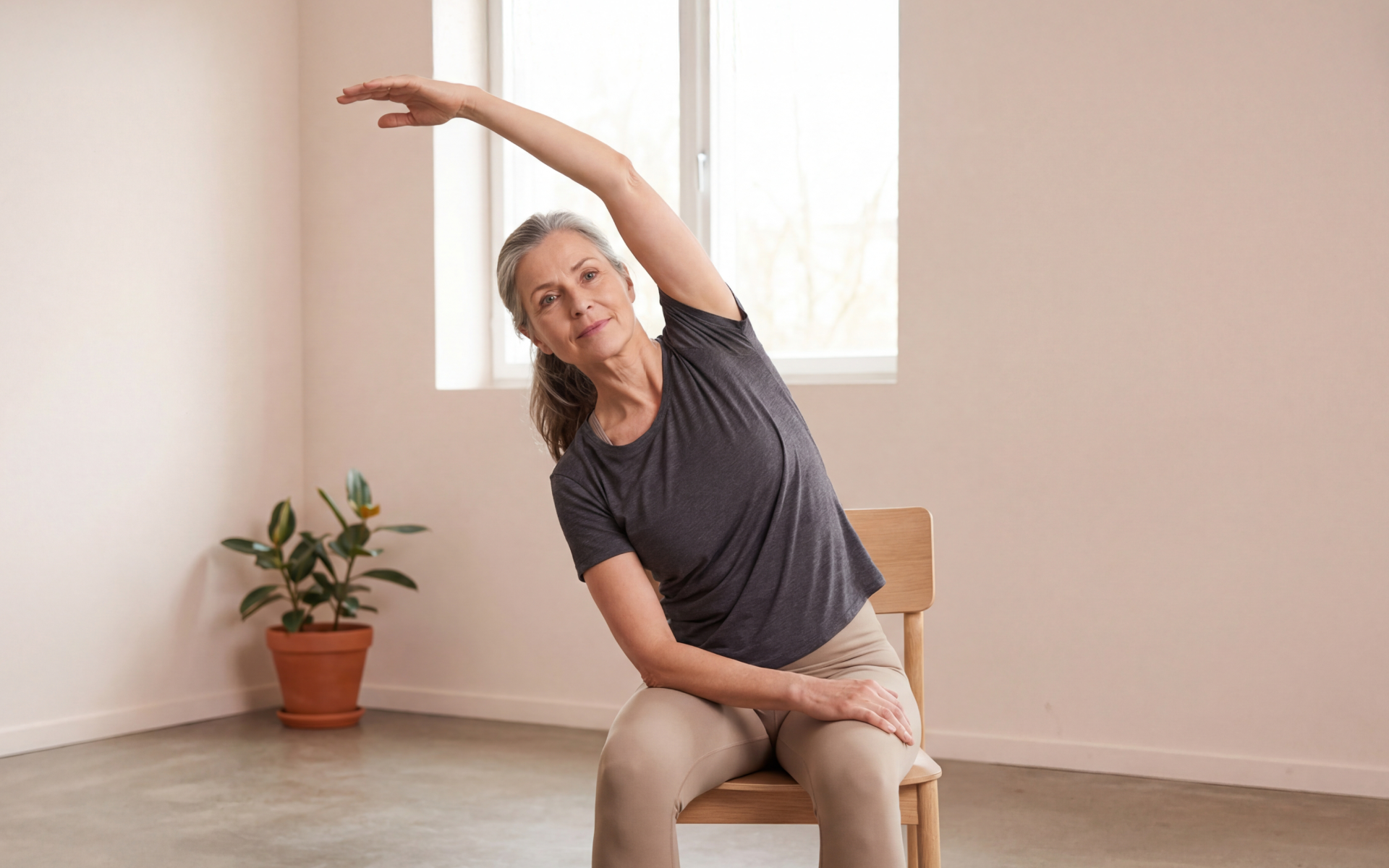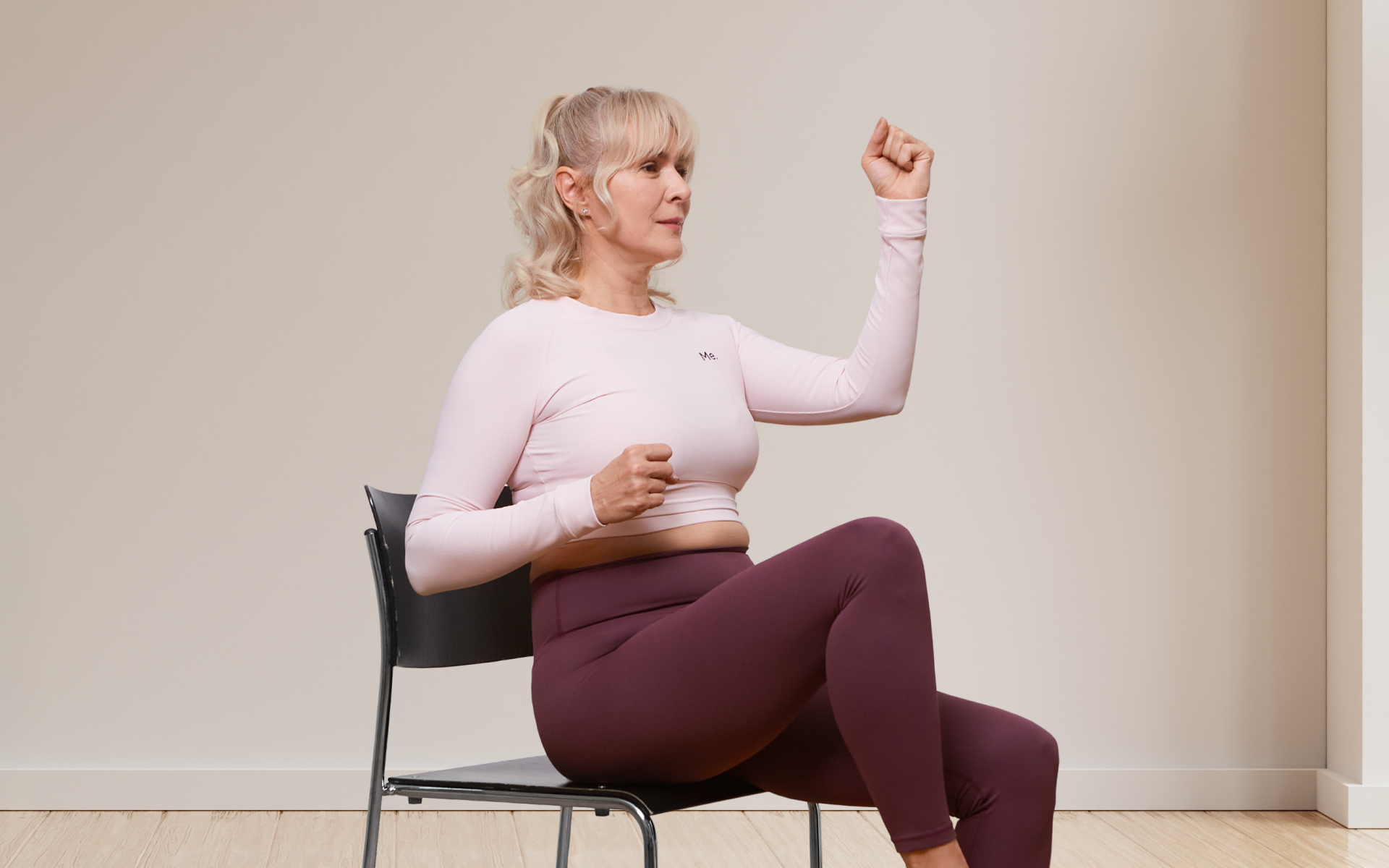Have you ever heard of the gut referred to as the “second brain”?
Well, there’s some truth to this statement. The gut plays a vital role in your overall health and well-being. It helps with digestion and also contains millions of neurons that communicate with your brain and affect your mood and emotions (1).
The gut-brain connection is a two-way street, which means that your mental and emotional state can also affect the health of your gut. Stress, anxiety, and depression can lead to digestive issues such as bloating, constipation, and even irritable bowel syndrome (IBS) (2).
It follows that stress-reducing activities, such as yoga, can also have a positive impact on gut health.
Chair yoga, which is a modified form of traditional yoga that can be done while sitting on a chair or using it for support, is an excellent option for people with limited mobility or those who may find traditional yoga poses too challenging.
What Is Chair Yoga for Gut Health?
Chair yoga for gut health is a collection of poses that target the abdominal area and help improve digestion, reduce bloating, and relieve symptoms of digestive disorders. These poses are gentle and low-impact and are designed to be done while sitting on a chair or using it for support. It’s an excellent option for people who may have difficulty with traditional yoga poses, such as those with chronic pain, injuries, or mobility issues.
Can Chair Yoga Improve Gut Health?
Chair yoga may improve gut health by reducing stress and tension in the body. When you’re stressed, your body enters into a “fight or flight” mode, disrupting digestive processes and causing symptoms such as bloating and pain (3).
By practicing chair yoga, you can activate the parasympathetic nervous system, which is also known as the “rest and digest” mode, that helps promote relaxation and better digestion (4).
Chair yoga poses for digestion may also:
Stimulate Digestive Organs
Yoga asanas, or poses, often involve gentle twisting and stretching movements that can stimulate digestive organs such as the stomach, intestines, and colon. These movements help increase blood flow to these areas, which promotes better digestion (5).
While yoga may help promote your gastrointestinal health, diet is the most important component. Find out more in our previous blog post, Foods to Improve Gut Health.
Balance the Solar Plexus Chakra
In yoga, chakras are energy centers in the body that correspond to specific organs and emotions. The solar plexus chakra, which is located in the abdominal area, is associated with gut health and self-confidence (6).
By practicing specific chair yoga poses that target this energy center, you can help balance and improve the flow of energy in this area, which promotes better digestion. Some poses that can help balance the solar plexus chakra include seated twists, cat-cow stretch, and downward-facing dog.
Promote Mindful Eating
Chair yoga for gut health isn’t just about physical exercises, it also involves breathing techniques and meditation. These practices can help you become more aware of your body and the foods you eat, promoting mindful eating habits.
Mindful eating has been proven to improve digestive issues such as bloating, gas, and constipation (7).
Strengthen Core Muscles
The internal obliques, which are abdominal muscles, play a crucial role in supporting your digestive system (8).
Chair yoga poses that target the core muscles can help strengthen them and improve gut health (9).
The BetterMe: Health Coaching app will provide you with a host of fat-frying fitness routines that’ll scare the extra pounds away and turn your body into a masterpiece! Get your life moving in the right direction with BetterMe!
Invert the Body
Some chair yoga poses involve gentle inversions, where the head is positioned below the heart. These inverted positions cause weight to shift in the abdomen, stimulating blood flow and promoting better digestion. When the bowel and stomach are inverted, any gas that is trapped in these areas can be released, which helps relieve bloating and discomfort.
Reduce Inflammation
Inflammation is a natural response of your body to injury or illness. However, chronic inflammation in the gut can lead to various digestive disorders such as Crohn’s disease or ulcerative colitis (10).
Some studies have suggested that regular yoga practice can help reduce inflammation in the body, including the gut (11).
Which Chair Yoga Pose Is Best for Digestion?
Below are some chair yoga poses that help with digestion and gut health:
1. Seated Side Bend (Parsva Sukhasana)
The seated side bend involves reaching one arm overhead while bending to the opposite side. It creates a gentle stretch along the sides of your body, especially in the rib cage and abdominal area.
By increasing the space for your organs, it can enhance circulation and help with digestion. It also promotes the stretching of the intercostal muscles, which can alleviate tension and discomfort in your torso.
Steps to execute the seated side bend:
- Sit upright in a sturdy chair with your feet flat on the ground.
- Relax your shoulders away from your ears.
- Inhale and raise your right arm overhead, reaching toward the ceiling.
- Exhale as you bend your torso to the left, feeling the stretch along your right side.
- Keep your left hand resting on your left thigh for support.
- Ensure that your hips remain grounded on the chair as you stretch.
- Hold the position for several deep breaths, focusing on the stretch.
- Inhale to come back to the center, lowering your right arm.
- Repeat on the other side by raising your left arm and bending to the right.
- Take a moment at the end to notice how your body feels.
Read more: 7 Chair Yoga Mobility Exercises for Seniors
2. Seated Forward Bend (Paschimottanasana)
The seated forward bend involves sitting tall and bending forward over your legs. It stretches the spine and hamstrings, creating a calming effect that can help relieve stress—a major factor that influences gut health. By encouraging relaxation, it can aid digestive processes as the body moves into a state of rest and digestion. It also helps massage the abdominal organs, further stimulating digestion.
Steps to execute the seated forward bend:
- Sit on the edge of a chair with your feet flat and hip-width apart.
- Take a deep inhale and lengthen your spine, raising your arms overhead.
- Exhale as you start to hinge forward at your hips, drawing your torso toward your thighs.
- Keep your back flat as you reach forward, either placing your hands on your knees or your shins.
- Relax your head and neck while breathing deeply into the stretch.
- Aim to keep your knees slightly bent if needed to avoid strain.
- Hold the pose for five deep breaths, letting go of tension.
- Inhale to slowly rise back up, stacking your spine vertebra by vertebra.
- Gently shake out your arms and legs to release any tightness.
- Repeat as desired, focusing on deepening the stretch each time.
3. Seated Half Twist (Ardha Matsyendrasana)
The seated half twist involves sitting tall and twisting your torso while keeping the legs stationary. This pose engages the digestive organs through gentle rotation, which facilitates better blood flow and promotes the elimination of waste. By enhancing mobility in the spine, it can lead to greater overall comfort during digestion. It also encourages deep, mindful breathing, which can alleviate tension and stress levels in the body.
Steps to execute the seated half twist:
- Sit comfortably in your chair with an upright posture.
- Place your left hand on the back of your chair for support.
- Inhale and lengthen your spine, sitting up taller.
- Exhale as you gently twist to the left, placing your right hand on your left knee.
- Keep your hips squared forward and breathe deeply into the twist.
- Hold the position for several breaths, allowing the twist to deepen naturally.
- Look over your left shoulder to enhance the stretch in the neck.
- Inhale to return to the center, unwinding gently.
- Repeat the twist on the right side, using the chair back for support again.
- After completing both sides, take a moment to notice how your spine feels.
4. Seated Cat-Cow (Marjaryasana-Bitilasana)
The seated cat-cow involves sitting on the edge of your chair and alternating between arching and rounding your back. This gentle motion stimulates the abdominal organs, enhancing blood flow and digestive function, and promotes spinal mobility. It also encourages awareness of breath and helps reduce stress, which is essential for a healthy gut.
Steps to execute the seated cat-cow:
- Sit at the edge of your chair with your feet flat on the floor, hip-width apart.
- Place your hands on your knees or thighs for support.
- Inhale deeply and arch your back, lifting your chest and looking slightly upward (cat).
- Exhale and round your spine, tucking your chin to your chest (cow).
- Continue this movement, flowing with your breath.
- Feel each vertebra moving and cultivating warmth in your belly.
- Aim for 5 to 10 cycles, allowing your body to move freely.
- After the last cycle, sit up tall and take a few deep breaths.
- Notice any sensations in your body as you pause.
- Gently shake out your arms and legs to release any tension.
5. Seated Knees-to-cChest (Apanasana)
The seated knees-to-chest involves drawing your knees toward your chest while seated, which creates a gentle compression in your abdomen. This position helps massage the intestines, which promotes better digestion. By compressing and releasing the stomach area, it enhances organ function, supporting overall gut health. It also provides a comforting stretch that can reduce stress and make it easier for the body to digest.
Steps to execute the seated knees-to-chest:
- Sit in a sturdy chair with your feet flat on the ground and your knees hip-width apart.
- Inhale and lift your feet off the floor, bringing your knees toward your chest.
- Wrap your arms around your shins or knees, holding onto your legs securely.
- Keep your spine straight and engage your core.
- Breathe deeply and hold this position for five breaths.
- As you exhale, gently press your knees toward your chest for a deeper stretch.
- Release any tension in your neck, allowing it to relax.
- After holding, slowly lower your feet back down to the floor.
- Take a moment to feel the effects in your abdomen.
- Repeat 2 to 3 times as desired.
6. Chair-Supported Bridge Pose (Setu Bandhasana)
Chair-supported bridge pose involves using your chair’s support to lift your hips while keeping your feet grounded. It encourages blood flow to the pelvic area, which can enhance digestion.
Lifting the hips opens the front of the body, allowing for deeper breaths and helping ease tension in the abdomen. It also mimics the benefits of a traditional bridge pose, promoting relaxation and physical well-being.
Steps to execute the chair-supported bridge pose:
- Sit at the edge of your chair with your feet flat and shoulder-width apart.
- Scoot your hips slightly forward to give room for your back.
- Place your hands on the seat of the chair beside your hips for support.
- Inhale deeply, and as you exhale, press your feet into the ground and lift your hips toward the sky.
- Tilt your pelvis slightly and open your chest.
- Keep your knees hip-width apart as you hold this position.
- Breathe deeply and maintain a gentle lift for 5 breaths.
- As you exhale, slowly lower your hips back down to your chair.
- Take a moment to notice the sensation in your body.
- Repeat this pose 2 to 3 times, focusing on your breath throughout.
7. Chair-Supported Gentle Backbend (Anuvittasana)
Chair-supported gentle backbend involves using your chair for support while gently arching your back. This pose opens up the front of the body and can stimulate the digestive organs. By extending the spine and chest, it encourages deeper breaths, which can help release any tension that’s held in the abdomen. It’s a wonderful way to re-energize while also being kind to your gut health.
Steps to execute the chair-supported gentle backbend:
- Stand facing your chair, with your feet hip-width apart.
- Place your hands on the backrest for support.
- Inhale deeply, and draw your shoulder blades together.
- As you exhale, gently arch your back, looking up toward the ceiling.
- Keep your core engaged for stability.
- Allow your body to naturally open without forcing it.
- Hold this position for 5-7 breaths, feeling the stretch.
- Slowly release by rounding your back and returning to a neutral position.
- Take a moment to notice any sensations throughout your body.
- Repeat if desired, focusing on your breath for deeper relaxation.
BetterMe is your fast-track ticket to long-lasting weight loss! Tailor your fitness journey and maximize your results with just a couple of swipes!
Will Yoga Flatten My Stomach?
Yoga may help you achieve a flatter stomach in combination with a balanced diet and regular exercise. Specific yoga poses can target the abdominal muscles, improving strength, stability, and appearance.
Yoga also helps reduce stress and promotes relaxation (12), which can help with digestion and decrease bloating in the stomach area.
However, weight loss or toning specific body parts is not the primary focus of yoga. Instead, the aim is to create balance and harmony throughout the entire body (13).
If weight loss is your goal, the most crucial factor is your diet. You must consume fewer calories than you expend, and ensure you have a good balance of all essential macronutrients, vitamins, and minerals. Combining this with exercise (including yoga) can help you achieve a flatter stomach (15).
Explore Yoga Poses for Bloating Relief in our previous blog post.
Is It Okay to Do Chair Yoga Every Day?
Whether you should do chair yoga every day depends on how intense your sessions are, whether you have any physical limitations, and your overall fitness level. It’s safe to do chair yoga every day if it feels comfortable for your body.
However, many experts recommend taking at least one day off per week to give your body a chance to rest and recover.
This is particularly important if you’re also doing other forms of exercise, such as cardio or strength training. It’s essential to listen to your body and adjust your practice accordingly.
If you have any injuries or limitations, it’s best to consult a healthcare professional before you start a daily yoga routine. They can provide personalized advice on what is safe and beneficial for your specific needs.
Read more: Chair Yoga for Muscle Building: Beginners Guide
FAQs
Can chair yoga reduce belly fat?
Chair yoga can help strengthen muscles in the abdominal area, but it’s not specifically designed for reducing belly fat. However, incorporating chair yoga into a healthy lifestyle that includes a balanced diet and regular exercise can contribute to overall weight loss and potentially reduce belly fat (15).
Check out more belly exercises you can incorporate in your flat tummy workout routine in our blog post, Chair Exercises for Stomach.
Does chair yoga count as exercise?
Chair yoga counts as exercise. The Merriam-Webster dictionary defines exercise as “bodily exertion for the sake of developing and maintaining physical fitness” (16).
Chair yoga involves physical movements that can improve strength, flexibility, and balance. It also requires mental focus and control while coordinating breath with movement, which makes it a form of physical activity that promotes overall health and well-being (17).
Does chair yoga tone your body?
“Toning” refers to increasing muscle definition and reducing fat (18). While chair yoga may not have the same intensity or resistance as weight training, it can still help tone and strengthen muscles throughout the body, including the core, arms, and legs. Consistent practice of chair yoga poses can also improve posture and balance, leading to a more toned appearance.
Is chair yoga a good workout?
Chair yoga is a good workout for many purposes; it can improve strength, flexibility, balance, and mental focus. It’s also a low-impact form of exercise that’s accessible for people of all fitness levels and abilities (17). However, if your goal is intense cardio or muscle building, you may need to supplement your chair yoga practice with other forms of physical activity.
The Bottom Line
Chair yoga is a gentle and accessible form of yoga that can be performed by people of all ages and abilities. It offers numerous benefits for overall health, including improving digestion and promoting relaxation. These seven poses are just some examples you can incorporate into your daily routine to support gut health and wellness.
Remember to listen to your body, modify as needed, and always prioritize your safety and well-being while practicing yoga. With regular practice, you may experience improved digestion, a flatter stomach, and an overall sense of calm and balance in both your body and mind.
DISCLAIMER:
This article is intended for general informational purposes only and does not serve to address individual circumstances. It is not a substitute for professional advice or help and should not be relied on for making any kind of decision-making. Any action taken as a direct or indirect result of the information in this article is entirely at your own risk and is your sole responsibility.
BetterMe, its content staff, and its medical advisors accept no responsibility for inaccuracies, errors, misstatements, inconsistencies, or omissions and specifically disclaim any liability, loss or risk, personal, professional or otherwise, which may be incurred as a consequence, directly or indirectly, of the use and/or application of any content.
You should always seek the advice of your physician or other qualified health provider with any questions you may have regarding a medical condition or your specific situation. Never disregard professional medical advice or delay seeking it because of BetterMe content. If you suspect or think you may have a medical emergency, call your doctor.
SOURCES:
- The Gut-Brain Axis: Influence of Microbiota on Mood and Mental Health (2018, ncbi.nlm.nih.gov)
- Gut Microbiome–Brain Alliance: A Landscape View into Mental and Gastrointestinal Health and Disorders (ncbi.nlm.nih.gov)
- Stress effects on the body (2023, apa.org)
- Breath of Life: The Respiratory Vagal Stimulation Model of Contemplative Activity (2018, frontiersin.org)
- Role of Yoga in Our Digestive System (2021, longdom.org)
- Everything You Need to Know About the Solar Plexus (Navel) Chakra (2024, yogajournal.com)
- Mindful Eating: A Review Of How The Stress-Digestion-Mindfulness Triad May Modulate And Improve Gastrointestinal And Digestive Function (2019, ncbi.nlm.nih.gov)
- Physiology, Gastrointestinal (2023, ncbi.nlm.nih.gov)
- Chair Yoga (2021, journals.lww.com)
- Chronic Inflammation (2023, ncbi.nlm.nih.gov)
- Impact of Yoga on Inflammatory Biomarkers: A Systematic Review (2018, ncbi.nlm.nih.gov)
- Reducing Stress with Yoga: A Systematic Review Based on Multimodal Biosignals (2023, ncbi.nlm.nih.gov)
- Exploring the therapeutic effects of yoga and its ability to increase quality of life (2011, ncbi.nlm.nih.gov)
- Optimal Diet Strategies for Weight Loss and Weight Loss Maintenance (2021, ncbi.nlm.nih.gov)
- Weight loss – a healthy approach (2024, betterhealth.vic.gov.au)
- Exercise Definition & Meaning (n.d., merriam-webster.com)
- How to Do Chair Yoga (2024, webmd.com)
- Toning vs. Bulking Up: What’s The Difference? – NASM (n.d., blog.nasm.org)





